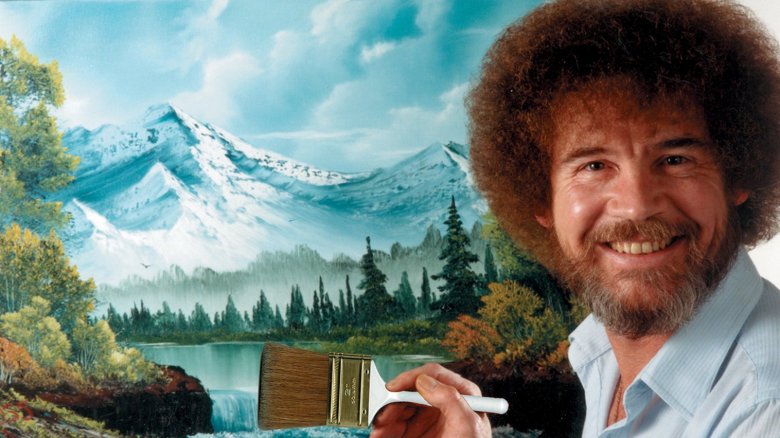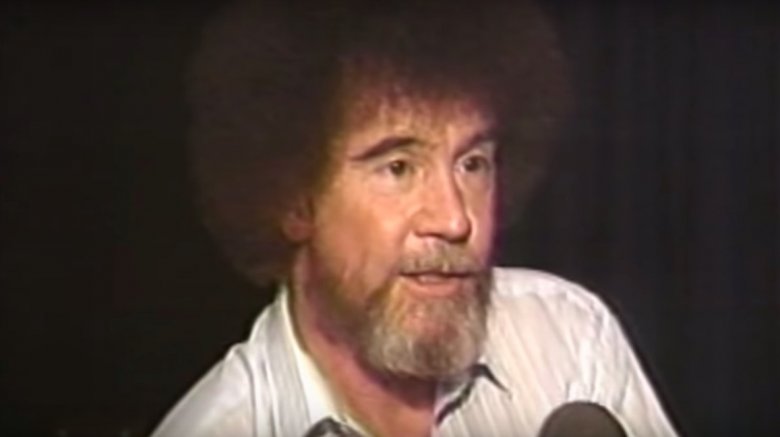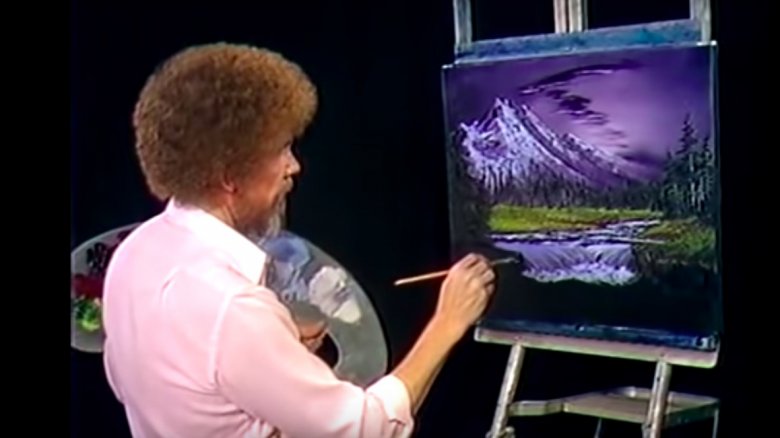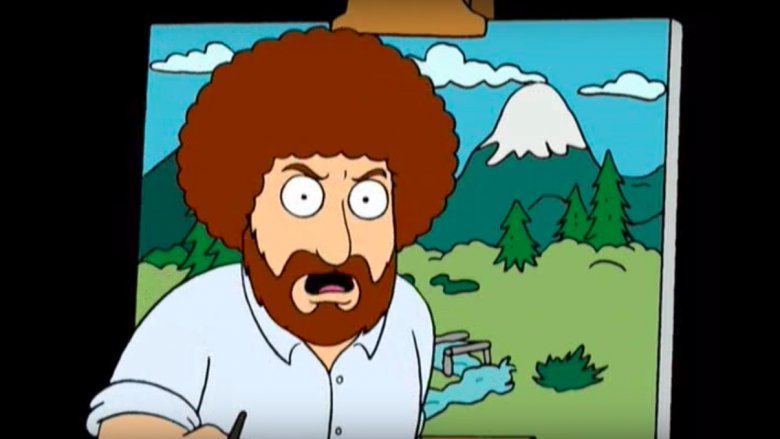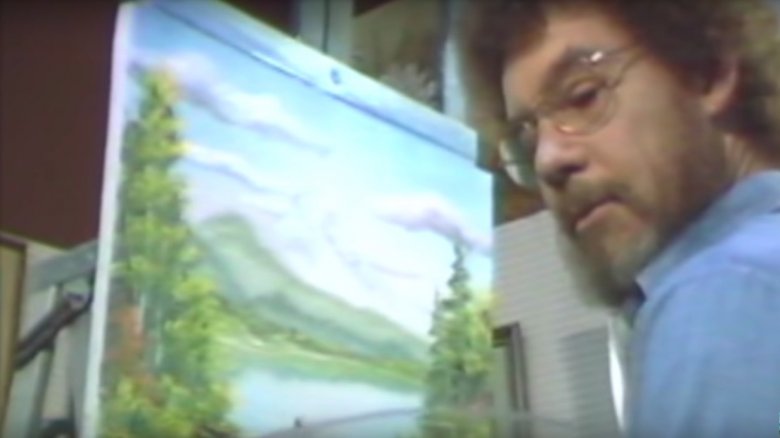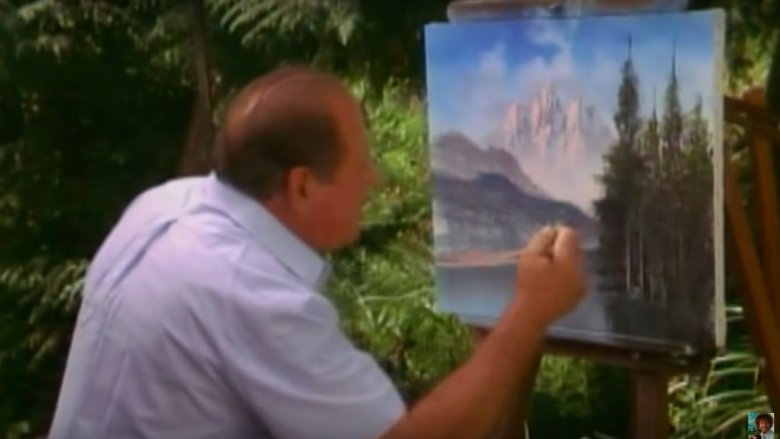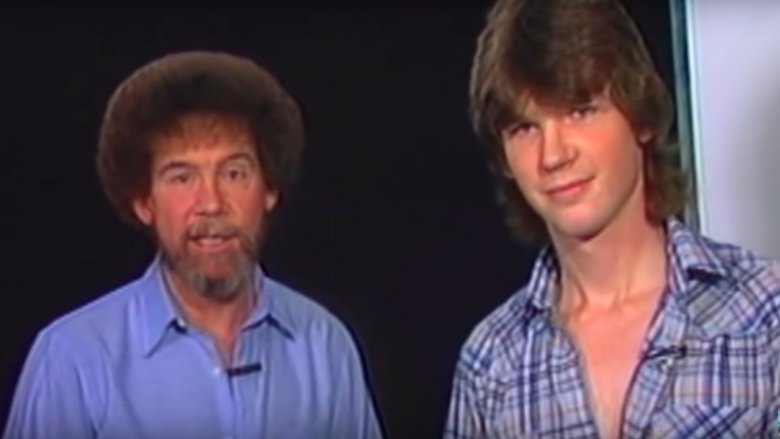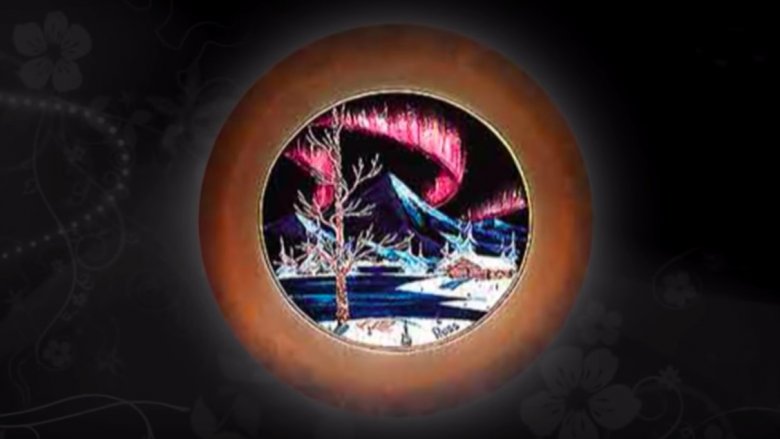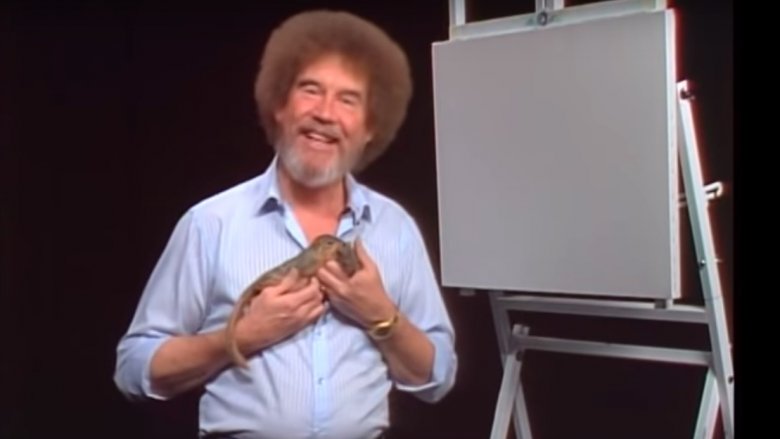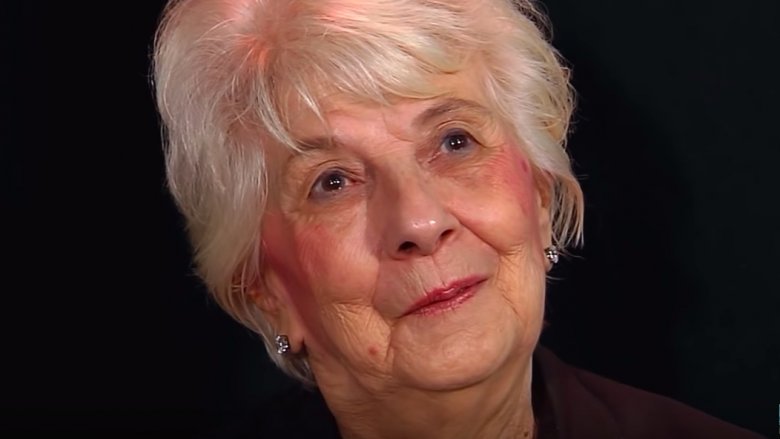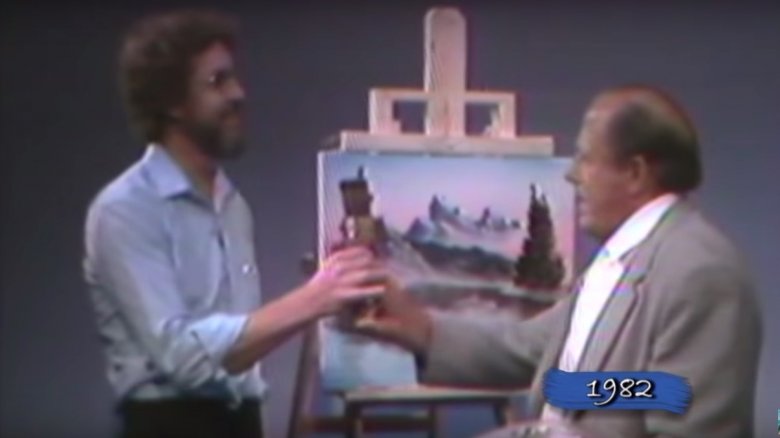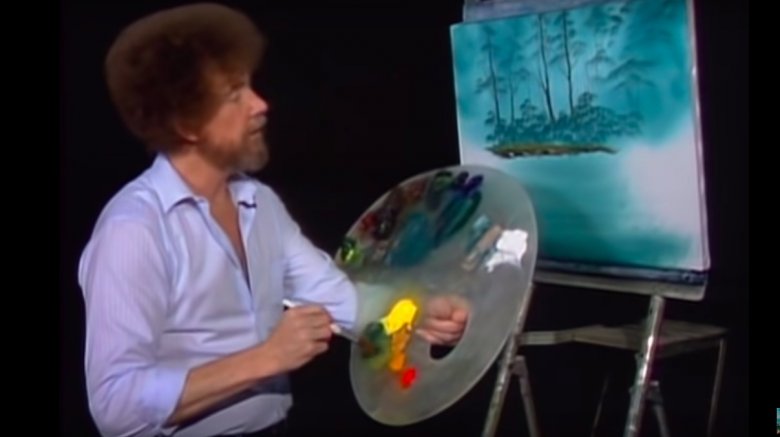What Bob Ross Was Like Before The Fame
Funny thing about Bob Ross: We all know who he is. It doesn't matter if you ever watched The Joy of Painting on PBS or if you're a professional artist or if you can't draw a stick figure or if you were born decades after he first became a thing. Everyone — everyone — knows about Bob Ross and his happy little trees.
So when we look back on the life of Bob Ross and his rise to fame, we are left with a singular question: What the heck? How did a guy with a PBS painting show become the big star we all still know and love today, years after his death? And why did 90 percent of his audience tune in with no intention of painting along or painting anything, ever? What was it about the guy that made him so fascinating to so many viewers? Well, you're in luck. We've dug into the past and discovered the real Bob Ross, before the fame and yes, before the afro.
OMG that wasn't Bob Ross' real hair
So let's just get this one out of the way right up front, so you'll have some time to recover. Bob Ross did not really have an afro. It was a perm.
Yes, it's true, Ross' hair was naturally straight. "He got this bright idea that he could save money on haircuts," longtime business partner Annette Kowalski told NPR. "So he let his hair grow, he got a perm, and decided he would never need a haircut again." So that was awesome from a saving-a-few-dollars-every-six-weeks perspective, but then Ross became famous and the signature afro got incorporated into his logo. Suddenly, he was full of regret. "He could never, ever, ever change his hair, and he was so mad about that," Kowalski said. "He got tired of that curly hair."
You have to admit, though, keeping the curly hair was a smart business move. Bob Ross' signature hairdo is so iconic that you instantly know who that silhouette, Chia Pet, or Lego figure is supposed to be. Bet you couldn't say the same thing about Picasso or da Vinci.
Bob Ross was intensely private
We should probably also mention that Bob Ross was a really private person. In fact he was so private, that just about everything we know about him comes from sources other than himself. In fact he was so super-extra private that even the people who wrote the book Happy Clouds, Happy Trees: The Bob Ross Phenomenon had to include a disclaimer that they weren't entirely sure what they were talking about. "[This book is] ... about an understanding we have of Bob Ross and his life," the authors wrote. "If we had wanted to write an accurate biographical book on Bob Ross, that goal would be difficult to accomplish."
A biography of Bob Ross does exist — the documentary Bob Ross: The Happy Painter. But if you're hoping to find something shocking or deeply personal in it, you're going to be disappointed.
Now, according to McMurray Art League, Bob Ross gave few interviews but was suspiciously coy about it. "I never turn down requests for interviews," he once said. "I'm just rarely asked." On the other hand, he also once admitted he enjoyed staying hidden and that he was often "sort of hard to find." So hard to find, in fact, that he evidently once moved to Orlando without telling PBS where he'd gone. So we kind of have to wonder how much of that whole never-asked-for-interviews thing was really just Bob Ross intentionally not answering the phone.
Bob Ross was inspired by the scenery of Alaska
Bob Ross was born in Daytona Beach, Florida, and raised in Orlando. If things had gone differently for him, he might have become famous for his paintings of happy little hurricanes, happy little retirement homes, and happy little alligators instead of those sweeping, mountainous landscapes he was so fond of. So how did he end up with an interest in alpine forests and towering peaks? When he was 18, he joined the U.S. Air Force, and the Air Force sent him to a military base in Fairbanks, Alaska.
That must have been a difficult adjustment for a guy who was used to winters where the average low temperature in January is like 50 degrees, but Ross appears to have adjusted admirably. According to Biography, he spent most of the next 20 years in the Land of the Midnight Sun, surrounded by natural beauty, and that's what inspired him to become a painter. It wasn't all happy trees and happy mountains, though. When Ross wasn't painting, he was filing. For most of his time in Alaska he worked as an Air Force medical records technician.
Ross always spoke fondly of Alaska, though, even after he left. "Ooh, if you have never been to Alaska, go there while it is still wild," he once said. He also had a sense of humor about it: "My favorite uncle asked me if I wanted to go there — Uncle Sam. He said if you don't go, you're going to jail. That is how Uncle Sam asks you."
Bob Ross was once called Bust 'em up Bobby
So what exactly did Bob Ross bust up to earn the nickname "Bust 'em up Bobby?" Was it paintbrushes? Palettes? The paparazzi? Actually Ross got that nickname in the Air Force because in the Air Force he kind of had a reputation as, shall we say, a person of temper.
You probably think we're making that up. The Bob Ross everyone knows was famous for his quiet, soothing voice, so it's hard to imagine the guy could have ever been a yeller. But in one of the few interviews he gave over the course of his career, he admitted that yelling had been a part of the job description. "I was the guy who makes you scrub the latrine, the guy who makes you make your bed, the guy who screams at you for being late to work," he said. "The job requires you to be a mean, tough person. And I was fed up with it. I promised myself that if I ever got away from it, it wasn't going to be that way anymore."
According to Military.com, Ross remained in the Air Force for 20 years and eventually reached the rank of master sergeant. And when he finally did leave the Air Force, he seems to have kept his promise to himself. Have you ever heard Bob Ross yell?
It took some time for Bob Ross to find his style
Bob Ross wasn't an artist when he got to Alaska. At least, it doesn't seem like he was, but because the dude never gave interviews we can't really say for sure that he never scribbled on his parents' wall as a toddler or doodled on napkins or added afros and mustaches and beards to school yearbook photos. But most sources seem to agree that Ross got his start at the Anchorage U.S.O. club, where he took an art class. According to the New York Times, he became hooked and eagerly sought out more art classes, but he disagreed with the teaching styles of a lot of his instructors. "The schools I went to, the professors were mostly into abstract — talking all about color theory and composition," he said. "They'd tell you what makes a tree, but they wouldn't tell you how to paint a tree."
Ross didn't really hide his disdain for abstract art and once even went so far as to diss Jackson Pollock's abstract expressionism. "If I paint something," he said. "I don't want to have to explain what it is." Everything changed when Ross learned the "wet on wet" method that he would later become famous for. "I took one class and I went crazy," he recalled. "I knew this was what I wanted to do."
Bob Ross was inspired by a German television painter
Okay, so we know how Bob Ross got his style, but how did he get from there to afro-sporting television star and art supply mogul? Well according to Military.com, after Ross learned to create a painting faster than most people can get ready for work in the morning, he started to see the business potential of his hobby. "I used to go home at lunch and do a couple [of paintings] while I had my sandwich. I'd take them back that afternoon and sell them." So evidently he was not just a prolific painter, he was also a sales and marketing genius.
Anyway, at that point he realized that he could earn more money as an artist than he did in the military, so off he went in pursuit of his dream. He got in touch with a guy named Bill Alexander (above), who hosted two PBS programs called The Magic of Oil Painting and The Art of Bill Alexander.
Ross studied under Alexander, then went on to teach Alexander's technique to the PBS television audience, much to his former mentor's chagrin. "I invented 'wet on wet,'" Alexander once complained. "I trained him and he is copying me." Note: Alexander didn't actually invent wet on wet. The technique has been around almost as long as oil painting itself has.
Bob Ross married three times and had two kids. We think.
A person's home and family life can say a lot about someone, but in Bob Ross' case, we really have nothing but dates and names to go by. Information about Bob Ross' wives and family are surprisingly difficult to come by, and generally speaking, most of what's been written about him in the media either avoids the subject altogether or comes to wildly different conclusions about just who he was married to and how many children he had. For example, if you believe one all-caps internet comment by a woman claiming to be Bob Ross' first wife, Vicky, Bob married her in 1965. They divorced in 1977 and had one child, a boy named Steve.
After his divorce, Ross got remarried to Jane Worstell. The couple remained together for 15 years — their relationship ended with her death in August 1992. His third and last wife was Lynda Brown, but he was only married to her for a couple months because he died from lymphoma not long after the wedding. The poster claiming to be Vicky Ross also claimed that Ross had a son named Bobby from a previous relationship, though Bobby did not take the Ross surname.
You know ... maybe! The internet is a weird place.
Bob Ross used to paint gold pans to earn extra cash
Bob Ross paintings are really hard to come by, even though he did 403 episodes of The Joy of Painting, which equals roughly 1,209 paintings since Mental Floss says he always did three versions for each show. Ross claimed he donated most of the paintings he did on the show to PBS stations to help with fundraisers. Those paintings were auctioned off, so presumably that means you can find a thousand or so original Bob Ross paintings hanging in homes and businesses around the world. But Ross also claimed to have created roughly 30,000 paintings over the course of his lifetime, and no one really knows what became of the rest of them.
There are also some really unique Bob Ross paintings that date to way, way back, to Bob Ross' life before the fame. While he was still living in Alaska, Ross used to paint gold pans and sell them for extra cash. These gold pans still turn up occasionally — according to an NBC station based in Fairbanks, two of them were acquired by a local antiques store in 2018. The previous owner purchased the pans in 1971 for $25 apiece. Today they're worth about $3,500, and they were sold within one day. No wonder so many of Bob Ross' fellow artists seem to resent him.
Bob Ross loved animals and kept exotic pets
Bob Ross was an animal lover, and that's really not surprising based on his famously soft-spoken demeanor. In fact it wouldn't be especially surprising if some archival footage were to one day surface featuring Bob Ross skipping through the forest, surrounded by chirping birds and baby animals.
Ross' affection for all creatures great and happy dates all the way back to his childhood — he even once tried to rehabilitate an injured alligator in his family's bathtub, which must have gone over fabulously with his parents. According to Today I Found Out, at one point he also had an armadillo, and other sources say he rescued birds with broken wings and even kept an epileptic squirrel in his empty hot tub.
Bob Ross sometimes even brought animals onto the set of The Joy of Painting, and he wasn't shy about his fondness for feathered and furry things. "I guess I'm a little weird," he once said. "I like to talk to trees and animals. That's okay though; I have more fun than most people."
Bob Ross' voice was so mesmerizing that one woman bet nearly her entire fortune on him
Little known fact: Bob Ross had a business partner, and he basically wooed her into betting her future on him, much like the Pied Piper of happy little squirrels and art students. Annette Kowalski met Bob Ross while she was grieving her oldest child, who had just been killed in a car crash. "I was so devastated," she told NPR. "All I could do was lay on the couch and watch television."
One of the programs Kowalski used to tune into at that time was Bill Alexander's PBS program on painting. Kowalski's husband wanted to do something — anything — to get his wife off the sofa and back to life, so he decided to sign her up for one of Alexander's in-person classes, which was 900 miles away from the couple's home. But Alexander was no longer teaching those classes — instead it was Alexander's protege, Bob Ross.
At first, Kowalski was disappointed. But then, she experienced what millions of PBS viewers and random other people have experienced. "I was so mesmerized by Bob," she said. "Somehow, he lifted me up out of that depression. I just think that Bob knew how to woo people. I said, 'Let's put it in a bottle and sell it.'" Well, she became his manager and they ended up putting it in a paint tube, but close enough.
Surprise, being a professional artist was a struggle, even for Bob Ross
We like to think that fame is all about being "discovered," so it's tempting to believe that Bob Ross met Annette Kowalski and then they both lived happily ever after, but that's not really what happened. The pair struggled to gain momentum. According to NPR, Kowalski bought newspaper ads and booked seminars in shopping malls, but hardly anyone showed up. There was even an 800 number: 1-800-BOB-ROSS. We're not sure what callers actually heard when they dialed the number, but it was almost certainly soothing and probably contained multiple instances of the word "happy."
It wasn't until Ross filmed a TV commercial that things really started to happen. The commercial featured Bill Alexander handing Bob Ross a paintbrush, as a sort of symbolic passing of the torch. The pair took the spot to PBS, but only because they wanted help getting it ready for the air. But when PBS saw it, they knew Kowalski was on to something, and they signed Ross up to be their next on-screen art instructor. And thousands of happy trees later, here we are.
Bob Ross was self-conscious about his missing fingertip
Apart from the whole alligator in the bathtub thing, we don't know a whole lot about Bob Ross' childhood. We know his mom was called Ollie and his dad was called Jack. Their relationship was kind of troubled, and in the most confusing way possible for their son — evidently they divorced, got remarried to other people, divorced again, and then got remarried to each other.
So Ross was probably feeling a bit unstable as a child, and when he was in the ninth grade he decided to drop out of school and join his dad in the carpentry business, which is something he did not turn out to be very good at. According to All That's Interesting, the decision left him without a high school diploma and also with a missing index fingertip on his left hand, which was something he remained self-conscious about for the rest of his life. In fact when he appeared on The Joy of Painting, he would deliberately hold his palette in such a way that his injury was hidden from viewers.
